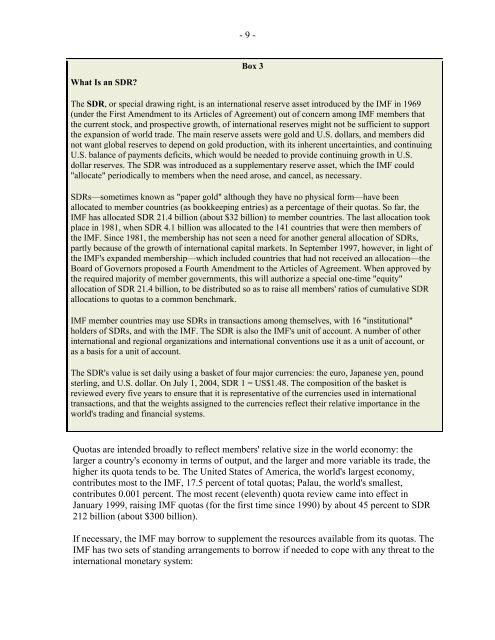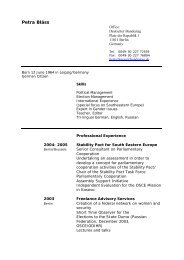What Is the International Monetary Fund? - the JVI eCampus!
What Is the International Monetary Fund? - the JVI eCampus!
What Is the International Monetary Fund? - the JVI eCampus!
Create successful ePaper yourself
Turn your PDF publications into a flip-book with our unique Google optimized e-Paper software.
<strong>What</strong> <strong>Is</strong> an SDR?<br />
- 9 -<br />
Box 3<br />
The SDR, or special drawing right, is an international reserve asset introduced by <strong>the</strong> IMF in 1969<br />
(under <strong>the</strong> First Amendment to its Articles of Agreement) out of concern among IMF members that<br />
<strong>the</strong> current stock, and prospective growth, of international reserves might not be sufficient to support<br />
<strong>the</strong> expansion of world trade. The main reserve assets were gold and U.S. dollars, and members did<br />
not want global reserves to depend on gold production, with its inherent uncertainties, and continuing<br />
U.S. balance of payments deficits, which would be needed to provide continuing growth in U.S.<br />
dollar reserves. The SDR was introduced as a supplementary reserve asset, which <strong>the</strong> IMF could<br />
"allocate" periodically to members when <strong>the</strong> need arose, and cancel, as necessary.<br />
SDRs—sometimes known as "paper gold" although <strong>the</strong>y have no physical form—have been<br />
allocated to member countries (as bookkeeping entries) as a percentage of <strong>the</strong>ir quotas. So far, <strong>the</strong><br />
IMF has allocated SDR 21.4 billion (about $32 billion) to member countries. The last allocation took<br />
place in 1981, when SDR 4.1 billion was allocated to <strong>the</strong> 141 countries that were <strong>the</strong>n members of<br />
<strong>the</strong> IMF. Since 1981, <strong>the</strong> membership has not seen a need for ano<strong>the</strong>r general allocation of SDRs,<br />
partly because of <strong>the</strong> growth of international capital markets. In September 1997, however, in light of<br />
<strong>the</strong> IMF's expanded membership—which included countries that had not received an allocation—<strong>the</strong><br />
Board of Governors proposed a Fourth Amendment to <strong>the</strong> Articles of Agreement. When approved by<br />
<strong>the</strong> required majority of member governments, this will authorize a special one-time "equity"<br />
allocation of SDR 21.4 billion, to be distributed so as to raise all members' ratios of cumulative SDR<br />
allocations to quotas to a common benchmark.<br />
IMF member countries may use SDRs in transactions among <strong>the</strong>mselves, with 16 "institutional"<br />
holders of SDRs, and with <strong>the</strong> IMF. The SDR is also <strong>the</strong> IMF's unit of account. A number of o<strong>the</strong>r<br />
international and regional organizations and international conventions use it as a unit of account, or<br />
as a basis for a unit of account.<br />
The SDR's value is set daily using a basket of four major currencies: <strong>the</strong> euro, Japanese yen, pound<br />
sterling, and U.S. dollar. On July 1, 2004, SDR 1 = US$1.48. The composition of <strong>the</strong> basket is<br />
reviewed every five years to ensure that it is representative of <strong>the</strong> currencies used in international<br />
transactions, and that <strong>the</strong> weights assigned to <strong>the</strong> currencies reflect <strong>the</strong>ir relative importance in <strong>the</strong><br />
world's trading and financial systems.<br />
Quotas are intended broadly to reflect members' relative size in <strong>the</strong> world economy: <strong>the</strong><br />
larger a country's economy in terms of output, and <strong>the</strong> larger and more variable its trade, <strong>the</strong><br />
higher its quota tends to be. The United States of America, <strong>the</strong> world's largest economy,<br />
contributes most to <strong>the</strong> IMF, 17.5 percent of total quotas; Palau, <strong>the</strong> world's smallest,<br />
contributes 0.001 percent. The most recent (eleventh) quota review came into effect in<br />
January 1999, raising IMF quotas (for <strong>the</strong> first time since 1990) by about 45 percent to SDR<br />
212 billion (about $300 billion).<br />
If necessary, <strong>the</strong> IMF may borrow to supplement <strong>the</strong> resources available from its quotas. The<br />
IMF has two sets of standing arrangements to borrow if needed to cope with any threat to <strong>the</strong><br />
international monetary system:



